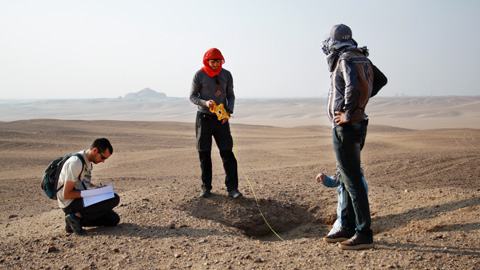The UAB conducts an archaeological rescue campaign in Saqqara

21/06/2019
A research team from the Department of Antiquity and Middle Age Studies and the Institute for Ancient Near Eastern Studies (IEPOA), both from the UAB, led by Egyptology Professor Josep Cervelló, worked together with the Antiquities Service in Egypt to conduct an archaeological survey in the south-western area of the Saqqara Desert, an area containing the famous Step Pyramid of Djoser, the first pyramid ever built in Egypt.
The team is currently on the site investigating the Kom el-Khamaseen necropolis and adjacent areas, with the aim of determining the number and typology of tombs and the individuals buried there, while also studying how this area's funerary space was organised in a period ranging from the end of the Old Kingdom up to the beginning of the First Intermediate Period (ca. 2200-2000 BCE). Researchers are also studying why several members of the Memphite court of different social conditions, some of them high-ranking officials, decided to be interred so far from the desert in the moment of the first crisis of the Egyptian centralised State.
Archaeological Rescue Mission
The team from the UAB Institute for Ancient Near Eastern Studies had already conducted an archaeological survey at the Kom el-Khamaseen site in 1997. This is when it observed that the remains discovered, mainly limestone blocks and granite blocks corresponding to already looted tombs, suggested that it was the site of a small necropolis from the end of the Old Kingdom. Although in 1999 the site was violently plundered and therefore no further work could be conducted at that moment, in posterior campaigns researchers studied the hieroglyphics engraved on the blocks left behind by looters and confirmed that the pieces belonged to the tombs of individuals from different social classes. Among them was Imephor, a great priest of the god Ptah in Memphis, capital of Egypt at that time. Since 2009 up until today, up to 30 pieces from the looting of 1999 have been found in art galleries, many of which were then confiscated and sent back to Egypt. As a result, the current mission is considered a rescue campaign, with urgent interventions.
The mission plans to conduct at least two ground campaigns, the first of which is currently underway. The campaign basically consists of an archaeological survey of a broad area adjacent to the Kom el-Khamaseen site, in preparation for the digs which will take place in 2020. During the survey other more minor and unknown archaeological sites were also documented, with a chronology which ranges from the Paleolithic up to the Byzantine period, passing through the Middle and New Kingdoms. The more important of these sites will also be included in the 2020 dig campaign.
The research, directed by UAB Professor Josep Cervelló from the Department of Antiquity and Middle Age Studies, also included the involvement of UAB egyptologists and archaeologists, such as lecturer from the same department Marc Orriols, topographer from the Catalan Institute of Classical Archaeology (ICAC) Josep María Puche, a team of Egyptian researchers led by Egyptologist Mohammed Mohammed Youssef, and researcher from the University of Basel, Switzerland, Zulema Barahona.